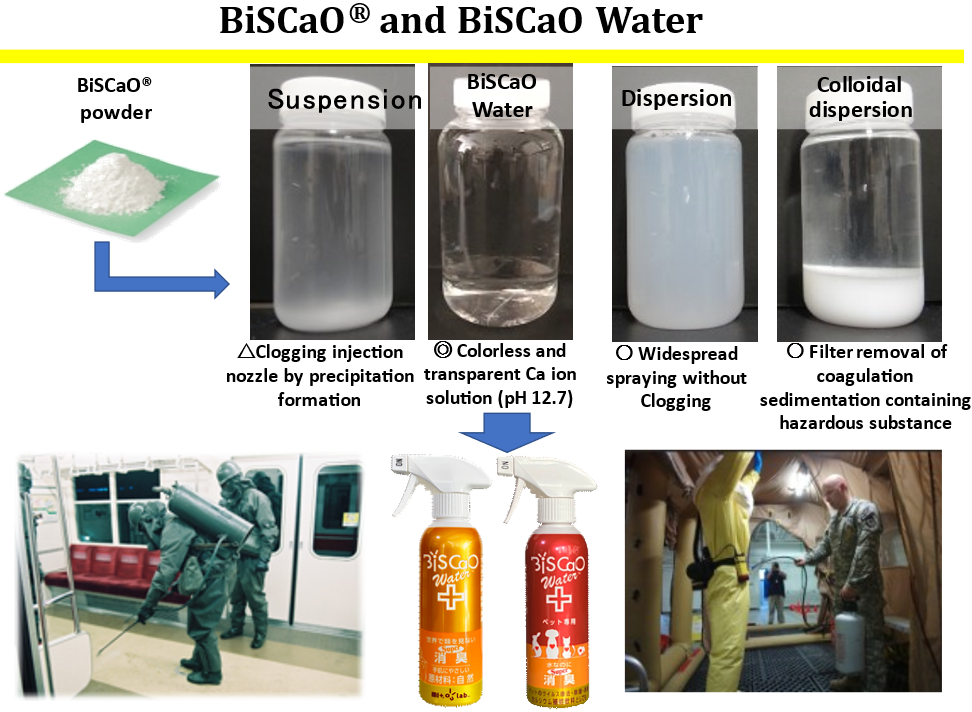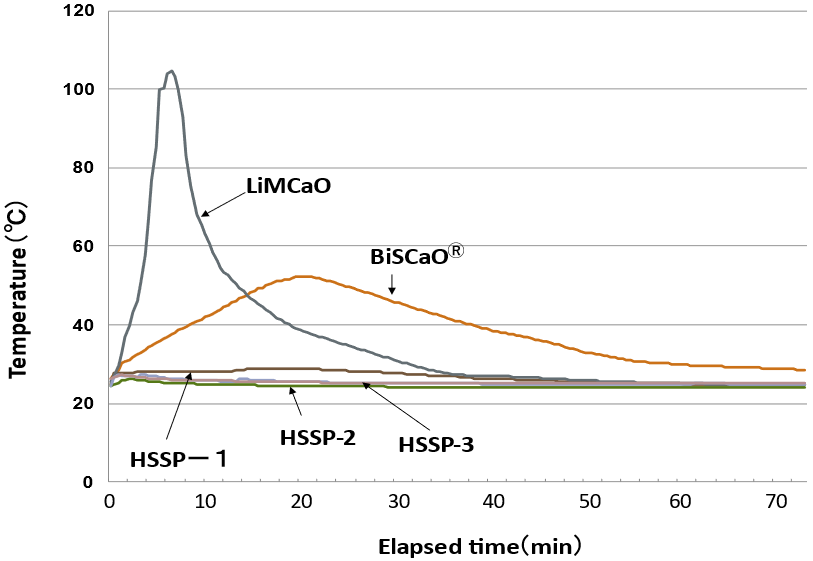BiSCaO ![]()
 Water: Unprecedented
Water: Unprecedented
Product of Disinfectant in the World
Most scallop shells are considered to be industrial waste, and the shells accumulate on the shores of harvesting districts in Japan, causing serious problems such as offensive odors and soil pollution due to harmful materials such as shellfish poisons and heavy metals. PLUS LAB Co., Ltd. has developed “BiSCaOⓇ” special calcium oxide powder synthesized by the cutting-edge technology (see Fig. 1). It is manufacutured by heating Scallop shell powders at 1450°C for several hours and by grinding them with a dry fine crusher (Nano Jetmizer) after cooling.
Disinfectant “BiSCaO Water” is produced by automatic adding BiSCaOⓇ to chilled clean water and decanting the supernatant into a separate container with reduced air-contact. It has superior disinfection and deodorization performances than the other commercial heated scallop-shell products (hereinafter called HSSPs). Furthermore, BiSCaO Water is a potent reagent that may overcome the obstacles of being strongly alkaline, making this material appropriate for use in disinfection against pathogenic microbes.

Fig. 1 Product outline and images of BiSCaOⓇ/BiSCaO Water
Major Features and Advantages
- The content of CaO in the BiSCaOⓇ is over 99.6%, and average diameter of the powder is about 6 µm.
- BiSCaO Water has stronger disinfection and deodorization effect than the other HSSP-based disinfectants.
- The pH of BiSCaO Water sprayed onto palm immediately decreases to 12 after 1 min, and continued falling to pH 10 (weak alkaline) after 5 min.
- BiSCaO Water can be applied to human such as hand sterilization without apparent harmful effects such as rough skin.
- BiSCaO Water is non-irritant in Skin Irritation Test, non-toxicity in Acute Oral Toxicity Test and non-irritant in Eye Irritation Test performed by Japan Food Research Laboratories.
- BiSCaOⓇ contributes the reduction of scallop-shell waste.
Technology Data
Technology data
Possible applications
Some disinfectants, such as ethanol and chlorine-based disinfectants show significant disinfectant activities, particularly against SARS-CoV-2 resulting from disruption of the viral envelope. However, ethanol is flammable and the usage of ethanol is limited by Halal restriction in Islamic countries. Chlorine-based reagents are ineffective in low-concentration whereas high-concentration generate harmful compounds to environment and living tissue.
BiSCaO Water is a highly concentrated Ca2+ ion solution (pH > 12.7), and colorless and transparent. This reagent has higher deodorization and disinfection activities than other disinfectants such as ethanol, HClO, and other HSSPs. The high initial pH of BiSCaO Water following application to various surfaces and skin, it rapidly decreases with the generation of CaCO3 as a result of the interaction between Ca2+ in BiSCaO Water and CO2 in the air. The characteristics of BiSCaO Water, including both its safety and disinfection effect, may be valuable for limiting the spread of various pathogenic microbes and viruses in various developing countries, especially Islamic countries.
Competitive advantage
【Comparison with other CaO/HSSPs】
HSSPs are available source of calcium hydroxide (Ca(OH)2) which are used as a food additive and environmental hygiene materials. The main component of the most commercially available HSSPs is calcium hydroxide (Ca(OH)2) generated by hydration of CaO. The content of CaO in BiSCaOⓇ is over 98% by TG-DTA and XRD analyses, and average diameter of the powder is about 6 µm. On the other hands, BET surface area of BiSCaOⓇ is lower than others, regardless of its particle size (Table 1). On the other hands, The content of Ca(OH)2 in HSSPs-1~-3 are over 80% and their BET surface are higher than BiSCaOⓇ.
Table 1. Chemical and physical properties
 *LiMCaOⓇ: calcium oxide synthesized from limestone
*LiMCaOⓇ: calcium oxide synthesized from limestone
Fig. 2 presented the SEM images of dry powders of BiSCaOⓇ, LiMCaOⓇ, HSSP-1, and HSSP-2. BiSCaOⓇ is a polymorphic powder with a dense cocoon-like surface structure, while HSSP-1 and HSSP-2 are a complex porous surface structure. On the other hand, LiMCaOⓇ is a complex lattice surface structure. The lower BET surface area of BiSCaOⓇ may attribute to the surface structure.
 Fig. 2 Electron microscopic images
Fig. 2 Electron microscopic images
As shown in Fig. 3, HSSP-1~-3 generate little heat of hydration since their major component is Ca(OH)2 instead of CaO. In contrast, 20 wt% LiMCaOⓇ in water immediately generated the heat and boiled in 5 min, and the temperature decreased to 60℃ after 10 min. BiSCaOⓇ (20 wt%) gradually generated the heat and the temperature reached over 50℃ after 20 min. The observation suggested that water can immediately penetrate to deep inside of LiMCaOⓇ and start the hydration reaction. On the other hands, in BiSCaOⓇ the hydration reaction first occurs on the surface and gradually progresses inside. Thus, although there is a risk of burns by the heat of hydration in LiMCaOⓇ, the risk of heat can be reduced and controlled in BiSCaO.
 Fig. 3 Comparison of heat of hydration between BiSCaOⓇ and other CaO/ HSSPs
Fig. 3 Comparison of heat of hydration between BiSCaOⓇ and other CaO/ HSSPs
CaO-based BiSCaOⓇ and Ca(OH)2-based HSSPs generate a strong base and high pH, and are certainly the main contributor to the considerable sterilizing effect. However, the controlled heat of hydration and active radical species generated from BiSCaOⓇ (data not shown) could be an alternative sterilizing factor, which could surpass conventional HSSPs. In fact, the other HSSPs do not exhibit the controlled heat of hydration and generation of the active radical species.
Furthermore, BiSCaO Water (pH > 12.7) is produced by repeatedly (more than 50 times) adding 10 wt% BiSCaOⓇ to chilled clean water and gently decanting the supernatant into separate container. The BiSCaO Water is also confirmed to be stronger activity and safety, compared to the other HSSPs-based alkaline liquids.
【Safety to human body】
BiSCaO Water can apply to human such as hand sterilization and without apparent harmful effects such as rough skin. When BiSCaO Water was sprayed onto palm, the pH immediately decreased after spraying, Furthermore, Japan Food Research Laboratories have evaluated that BiSCaO Water is non-irritant in skin and non-toxic. Thus, BiSCaO Water showing efficiency and safety is an unprecedented product all over the world as a disinfectant.
Performance
Content of CaO in the BiSCaO® is over 99.6%, and average diameter of the powder is about 6 µm. Since the BiSCaO® is little water-soluble in strong alkaline condition (pH > 12), the generated precipitations in water suspension of high concentrations of BiSCaO (>0.2 wt%) can result in its significant loss as well as plugging a spray nozzle.
On the other hand, BiSCaO Water is a highly concentrated Ca2+ ion solution (pH > 12.7) and colorless and transparent solution. The high initial pH of BiSCaO Water following application to various surfaces and skin, it rapidly decreases to pH < 10 within 5 min with the generation of CaCO3 as a result of the interaction between Ca2+ in BiSCaO Water and CO2 in the air.
【Sterilization Performance】
Fig. 4 shows sterilization effects with BiSCaO Water, hypochlorous acid (HClO), and ethanol against total viable cells (TC) and coliform bacteria (CF). The CFU/ml for floating TC and CF with 75 and 50% of BiSCaO Water, HClO, and ethanol were below detection limit, indicating those three disinfectants has strong sterilization activities. The sterilization activities decreased with lower concentrations of each disinfectant with less than 25% and all the three disinfectants with 6.25% have little activities. There are no significant differences in sterilization activities between those three disinfectants (6.25, 12.5 and 25 % ).
 Fig. 4 Sterilization effect of BiSCaO Water, HClO, and ethanol against TC and CF
Fig. 4 Sterilization effect of BiSCaO Water, HClO, and ethanol against TC and CF
All three disinfectants at same concentrations have enough deodorization and sterilization activities The comparisons of BiSCaO Water, ethanol, and HClO on impact to environmental and living body have been described in Table 2, Thus, BiSCaO Water is superior to ethanol and HClO in safety.
Table 2 Impact of BiSCaO Water on the environment and living organisms

Technical maturity / Past record of introduction
BiSCaO was developed by the collaborative research with Dr. Masayuki Ishihara, a professor emeritus of National Defence Medical College in Japan.
Some notable milestones
- BiSCaO developed in 2018 after more than 3 years of R&D
- BiSCaO Water developed in 2019. Tested by National Defense Medical College
- BiSCaO Water used by National Defense Medical College medical staff dispatched to attend to Covid-19 patients on the Diamond Princess cruise ship in early 2020 and at the Osaka Corona Intensive Care Center in mid-2021
- BiSCaO Water sold in shops throughout Japan since mid-2020
- Tests by Japan Food Research Laboratory in April 2020 for virus removal, sterilisation comparison with other disinfectants.
- Tests by National Defense Medical College throughout 2020 for deodorant effect, anti-bacterial on hands and masks, and improved wound healing.
Academic Journal (Japanese)
– Defense Technology Journal, August 2021: 11-19.
– J. Antibact. Antifung. Agents, Vol.49, No.8, pp.405−411 (2021)
Information on patent related to this technology
JPA No.2020-0288809
Company Data
Company data
| Name | Plus Lab Co., Ltd. |
| Address |
Registered Office: 4-7 Ubahata Shiroganemachi, Hachinohe-shi, Aomori, 031-0822 Japan |
| Capital | 5 million (as of April 1, 2022) |
| Contact person |
Mr. Shinichi SAWADA |
| Number of employees | 7 (as of April 1, 2022) |
| Date of company foundation | January 30, 2014 |
| Type of business | Application development, manufacture, and sales of decontamination, deodorant, and cleaning agents |
International operation
| Number of employees for international operation |
2 | |
|
Overseas offices |
City, Country | Name of Company (if applicable) |
| Kuala Lumpur, Malaysia | Contact Person: Mr. Chong Shao Yen (Executive Director International Business Leader) | |
Modality of business transaction
Partnership
Strategic partnership with a manufacturer of, for example, a water filter machine in emerging countries who would like to enhance its water quality from, for example, hand wash quality to drinking quality. Plus Lab can work in partnership with that manufacturer to develop a system to use BiSCaO or BiSCaO Water to purify water. Plus Lab is flexible on a win-win financial arrangement(s) for both parties.
Export of product
Although the sale and the financial arrangement (Letter of Credit or similar) is straight forward, Plus Lab will work with the importer in an emerging country to efficiently and correctly handle, package and distribute BiSCaO and /or BiSCaO Water. In a way, the parties become like “business partners”.
Licensing of patent
Distributor in an emerging country would like to have the license to buy BiSCaO to make BiSCaO Water. Plus Lab is prepared to discuss the terms of the licenses (i) to buy BiSCaO and (ii) to make BiSCaO Water and to provide the technical support to the license holder. Again, Plus Lab is flexible on a win-win financial arrangement for both parties.
Attachments
Schematic illustration of the technology
BiSCaOⓇ may also be used as adsorbent for the purpose of soil amelioration. Plus Lab has conducted R&D to evaluate effectiveness of adsorption removal for heavy metals and harmful organic compounds.
Contact Person(s)
*Please mention that you saw UNIDO's website when making the first contact with the company.
Registered Category
- Environmental Technologies : Circular Economy (3R)
- Human Health Technologies : Public health

